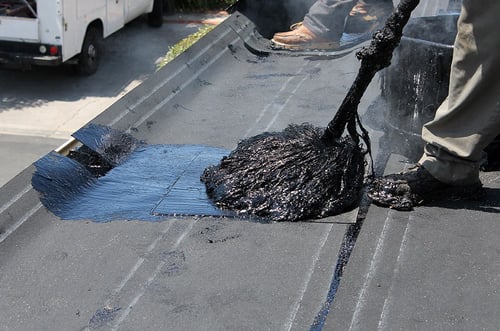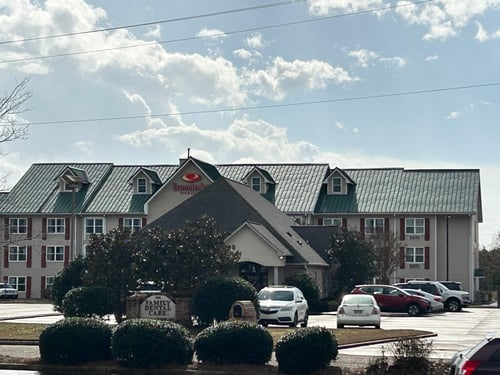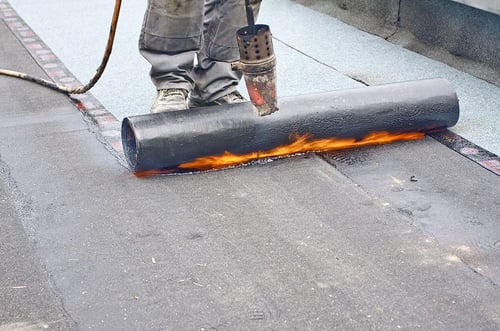
Commercial roofing: the unsung hero of every business, keeping you and your assets safe through rain, hail, and heavy winds. It may not be the most glamorous part of your building, but trust us, it's the most important. After all, a leaky roof can quickly turn a sunny day into a soggy nightmare.
At RoofCrafters, we know that choosing the right commercial roof for your business is important for several reasons. First and foremost, your roof is responsible for protecting your business, employees, and customers from the elements. A poorly chosen or installed roof can lead to leaks, water damage, and even structural issues, putting your business at risk and potentially causing costly repairs down the road.
That being said, if you’re reading this article, it’s safe to say you’ve had a question or 2 raised by your commercial roof, and you’re wondering what your replacement and material options are. It’s a good thing you’re here because, in this article, I’ll be explaining what the 5 most common commercial roof types are, and things to consider before choosing the material for your next roof installation. Let’s get started!
What Are the 5 Most Common Commercial Roof Types?
While there are several different types of commercial roofing to choose from, the 5 most popular options include:
- Built-up Roofing (BUR) - also known as tar and gravel roofs, BUR roofs consist of multiple layers of asphalt and fiberglass or organic felt material.
- Single-Ply Roofing - a type of roofing that consists of a single layer of synthetic polymer or rubber material, typically PVC or TPO.
- Metal Roofing - metal roofs are durable and energy-efficient and come in a range of materials including steel, aluminum, and copper.
- Modified Bitumen - a type of asphalt roofing that is modified with synthetic materials to increase its durability and flexibility.
- Foam Roofing - a type of roofing that is sprayed onto the roof as a liquid, then expands and hardens into a durable foam layer.
Built-Up Roofing
Built-up roofing (BUR), also known as tar and gravel roofing, is the most frequently asked about flat roofing systems. BUR roofs consist of multiple layers of reinforcing materials, such as fiberglass or organic felt, that are saturated with asphalt and installed in overlapping layers.

The installation process typically involves alternating layers of asphalt-saturated felt or fiberglass and hot tar, with a layer of gravel or mineral granules applied on top to protect the roof from the elements and provide a barrier. The layers of the BUR roofing system create a strong, durable, and waterproof surface that can withstand exposure to the elements, such as rain, wind, and sunlight. The number of layers in a BUR roof can vary depending on the specific needs of the building and the climate in which it is located.
Single Ply Roofing
Single-ply roofing is a type of roofing system that consists of a single layer of flexible and durable thermoplastic or synthetic polymer material. It is often used on commercial and industrial buildings as it is cost-effective, easy to install, and low maintenance.
There are three main types of single-ply roofing membranes:
Polyvinyl Chloride (PVC): PVC roofing membranes are made from a durable and flexible plastic material. They are resistant to fire, chemicals, and UV rays, and can last up to 30 years with proper maintenance.
Thermoplastic Olefin (TPO): TPO roofing membranes are made from a blend of rubber and plastic materials. They are highly resistant to punctures, tears, and chemical damage, and are often used in areas with extreme weather conditions.
Ethylene Propylene Diene Monomer (EPDM): EPDM roofing membranes are made from a rubber material that is resistant to UV rays, ozone, and extreme temperatures. They are easy to install and maintain and can last up to 25 years.
Single-ply roofing membranes are typically installed using adhesive or mechanical fasteners and can be customized to fit the specific needs of a building. They are also available in a range of colors and thicknesses to meet specific aesthetic and functional requirements.
Metal Roofing
Commercial metal roofing is a popular option for businesses and industrial buildings due to its durability, energy efficiency, and low maintenance. Metal roofs are made from a variety of materials, including steel, aluminum, and copper, and come in a range of styles and colors.

Metal roofing systems can be installed on both sloped and flat roofs, and typically consist of metal panels or sheets that are attached to the roof deck using screws or clips. They can also be installed over existing roofing systems, which can save time and money on removal and disposal costs. One of the main advantages of metal roofing is its durability. Metal roofs can last up to 50 years or more with proper maintenance, and are highly resistant to wind, hail, and fire damage. They are also energy-efficient, reflecting sunlight and reducing heat absorption, which can help lower energy costs.
Modified Bitumen Roofing
Modified bitumen roofing is made from asphalt and a variety of synthetic materials, such as rubber or plastic, which are added to increase the durability and flexibility of the material. Modified bitumen roofing is typically installed in two or three layers, with each layer reinforced with a fiberglass or polyester mat. The layers are then adhered to the roof using a hot torch, hot asphalt, or cold adhesive.

One of the main advantages of modified bitumen roofing is its ability to withstand extreme temperatures and weather conditions. It is resistant to water, wind, and UV rays, and can withstand both high and low temperatures without cracking or splitting. Modified bitumen roofing is also easy to repair and maintain. It can be patched or repaired using similar materials and methods to the initial installation and requires only minimal maintenance to keep it in good condition.
Foam Roofing
Foam roofing is a type of roofing system that is made from a polyurethane foam material. It is commonly used on flat or low-sloped roofs and is particularly popular in commercial and industrial buildings due to its energy efficiency and durability. The foam material is sprayed onto the roof surface as a liquid and then expands and hardens, forming a seamless, monolithic layer. Once the foam layer has cured, a protective coating is applied on top to protect it from the elements.
Foam roofing is also lightweight and durable. It can withstand harsh weather conditions, including high winds, hail, and heavy rainfall, and can last up to 30 years or more with proper maintenance. Another advantage of foam roofing is its ease of installation and repair. The foam material can be applied quickly and easily, with little disruption to the building occupants. It can also be repaired easily by adding additional foam material and reapplying the protective coating.
Which Commercial Roof Is Right for My Business?
Choosing the right commercial roof for your business depends on several factors, including a budget, building design, climate, and maintenance requirements. Each type of commercial roofing material has its advantages and disadvantages, so it's important to consider all the options and weigh the pros and cons of each option before deciding to ensure that you choose the best roof for your business needs.
If you’re curious about the commercial roofing options in your area, it’s important to acquire several different roofing estimates from differing companies before choosing the contractor that’s the best fit for your roofing needs. If you’re struggling to find the best contractor for the job, be sure to download “The Top 10 Most Critical Questions You Want to Ask Your Potential Roofing Contractor”.
This checklist includes several different prompts to ask your roofer to prepare you to hold the company accountable for its quality of work and services when it comes to your upcoming roofing project.
My name is David Toth and I am the lead estimator in North Florida with RoofCrafters Roofing. Originally from New Brunswick, I have called Florida home for the past 47 years. I enjoy cooking along with traveling to different historical areas in Florida when I have free time.




